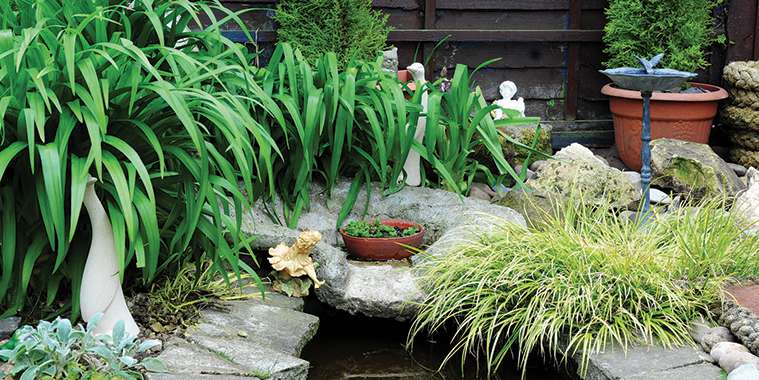There’s nothing like the sound of a babbling brook, the sight of a cascading waterfall, or the diverse flora and fauna of a pond. The beauty of these natural elements never fails to elevate our outdoor adventures. For many homeowners, creating the perfect backyard retreat is their way of bringing nature closer to home. If you’re planning to boost your yard appeal with the addition of water features, read on for inspiration!
1. Ponds
A pond is a reservoir of still, water contained in either a depression in the ground, or within a raised embankment. A well-designed and maintained pond can appear as real and diverse as those encountered in nature.
Pros: Ponds provide a beautiful, natural look with endless design possibilities and can often provide a suitable habitat for plants, fish, and amphibians.
Cons: Some ponds require costly excavations and their liners can become easily damaged and leak. A filter and regular maintenance may be required. Local regulations may also restrict size and depth.
Tip: Capture any summertime amphibious residents each fall and return them to the nearest large body of water so they can hibernate for the winter.
2. Waterfalls
Waterfalls can be incorporated with just about any pond or stream feature, and require a water pump system to draw water from the pond up to the waterfall’s apex.
Pros: Waterfalls add entrancing beauty and a unique ambiance to any yard with plenty of design possibilities. They provide stunning focal points, both visually and in conversation!
Cons: Children should be monitored closely around these water features. Maintenance can be costly and the moving water may attract potential pests (like raccoons and frogs).
3. Pondless waterfalls
A pondless waterfall provides all the ambiance and visual appeal of a waterfall, but uses a circulation system that pulls water from an underground reservoir instead of a pond.
Pros: Pondless waterfalls are ideal for smaller spaces, pose less of a drowning risk to small children, and are easy to maintain.
Cons: These systems require expensive equipment and installation and can greatly impact your electricity bill when running the pump 24/7.
4. Streams
A stream is a circulatory water system running along an extended area, and may start or terminate at a pond, or use an underground reservoir similar to that used by pondless waterfalls.
Pros: Streams are an excellent way to expand on existing water features and are ideal for larger yards with less need for vertical lifting by pumps. Their gentle sounds are quite pleasing and relaxing.
Cons: Their design and installation are both cost and labour intensive, requiring extensive excavation to accommodate the plumbing system. Be prepared for time-consuming maintenance and winterizing procedures.
5. Rain curtains
A rain curtain (or water curtain) is a standing arch-like structure made from iron, wood, stone, or concrete which pumps water through a row of small holes to create the effect of falling rain in a controlled area.
Pros: Rain curtains are visually appealing and produce a relaxing white noise. They can be made (check out this amazing DIY how-to!) and purchased in a wide range of looks requiring little to no maintenance.
Cons: Rain curtains are not advisable if you have small children, and it’s important to choose the right location. Some neighbours may not appreciate the sound; check in with them as part of your planning process.
6. Fountains
A fountain is a structure or device through which water is pumped from spouts into the air and is usually part of a pool or pond installation.
Pros: Fountains are diverse features offering nearly unlimited design flexibility and can be used with just about every other type of water feature. They bring a timeless element to any landscaping project.
Cons: Complex fountains are expensive and most are maintenance intensive. Because they are usually used alongside ponds or pools, it’s advisable to avoid them where small children live.
Tip: Fountains in natural ponds help discourage mosquitoes from laying their eggs because of the agitated water surface.
7. Birdbaths
If you’re just looking for something simple to entice our feathered friends to your yard, then a birdbath is just the thing. A birdbath is any shallow vessel made to hold water for birds to drink and bathe in.
Pros: Birdbaths are the most affordable water feature, easy to maintain, and attracts many bird species. They also provide a water source for both bees and wasps.
Cons: Birdbaths need to be refilled each day and require weekly cleaning.
Tip: Replace the water each day with fresh water to control mosquitoes by removing their opportunity to lay eggs.
Whether you’re intent on making your yard the talk of the neighbourhood, or creating the ideal oasis to accompany your outdoor fireplace, there’s so much you can do with water features. But, if you’ve got a different kind of water feature in mind, then it’s time to take the plunge and consider a swimming pool for your yard.
— Realtor.ca



